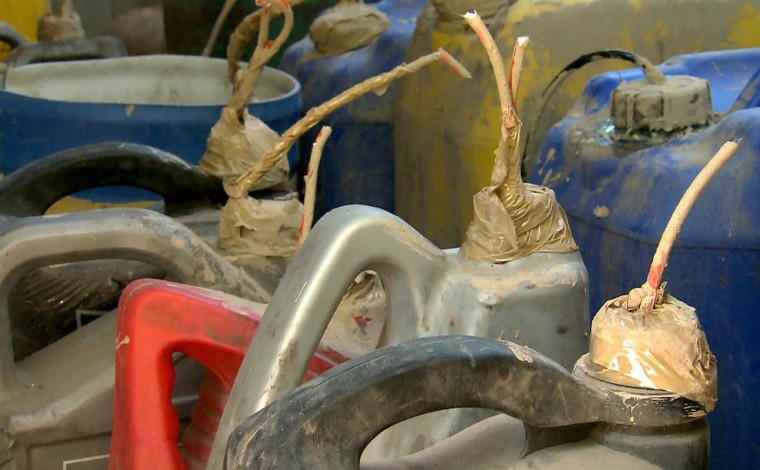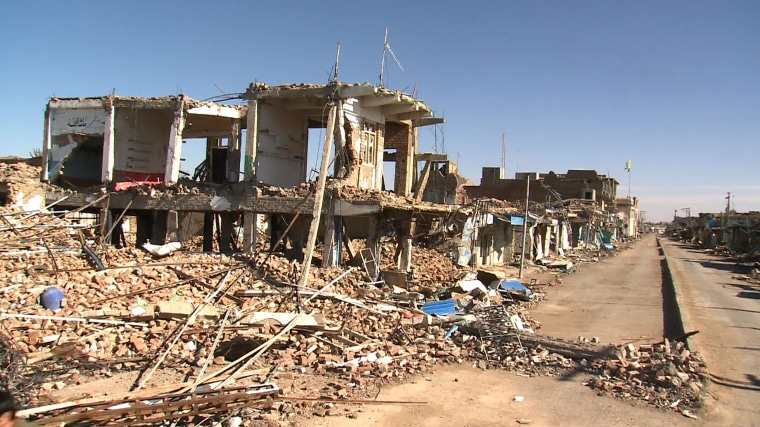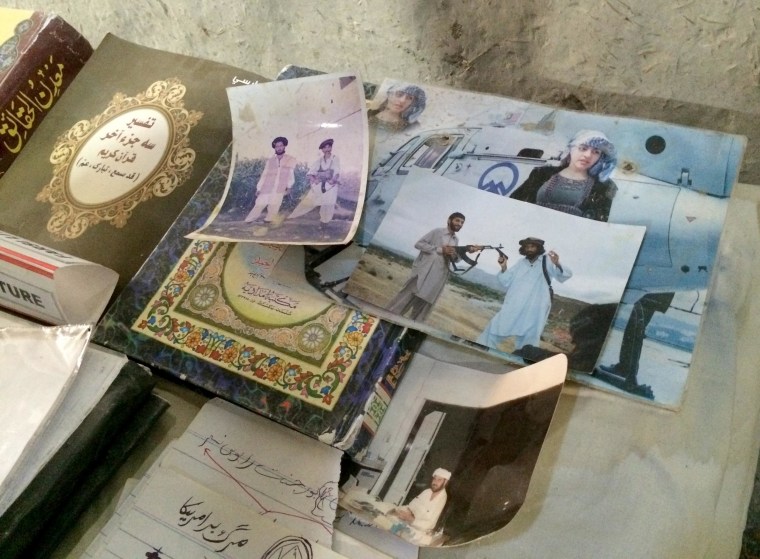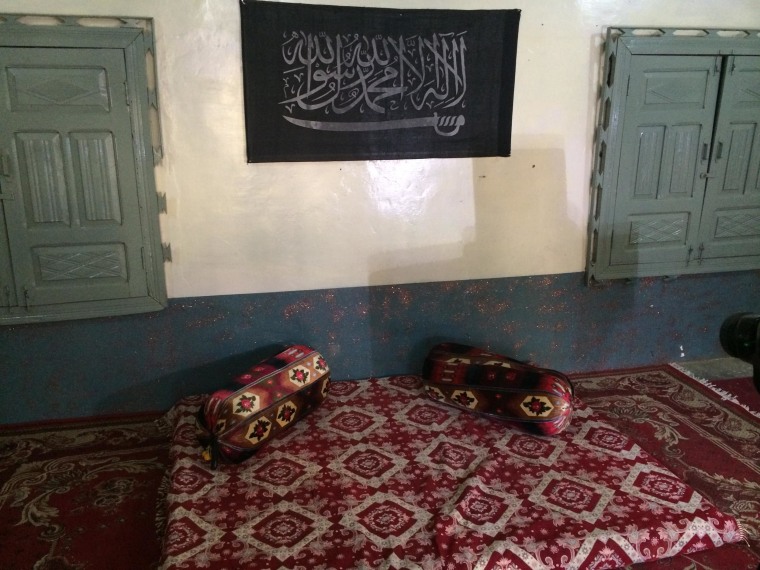Editor's note: The Peshawar school massacre follows pledges by the Pakistani Taliban to retaliate for an offensive targeting militants in North Waziristan that was launched in June. Here's what NBC News' Wajahat S. Khan found when he visited two towns that had been devastated by the offensive on Nov. 14.
MIR ALI, Pakistan — A television studio for suicide bombers, a market offering car bombs in a variety of colors and a secret tunnel filled with rotting corpses under the local mosque. These were aspects of daily life in the militant-controlled mountain area of North Waziristan, according to Pakistan's military.
A lawless region near the Afghan border, North Waziristan has long been a haven for some of the world's most-feared terror groups. It was a hotbed for the Pakistani Taliban and the Haqqani network — which held Sgt. Bowe Bergdahl for five years.
After years of pressure from the U.S. and increasing terrorism within Pakistan, the Pakistani military launched a huge offensive in June to dislodge the fighters. Dubbed Operation Zarb-e-Azb — or "Strike of the Prophet’s Sword" — it has forced at least 700,000 civilians to flee their homes and left entire towns rubble-strewn and virtually deserted.
Pakistan's military claims to have killed 1,200 militants and says it has recovered 200 tons of improvised explosive devices [IEDs] and ordnance. This is "enough for the militants to keep on conducting five IED attacks [per day] ... for 14 and half years," Maj. Gen. Zafar Khattak told NBC News at a brigade headquarters near Mir Ali.

During a drive through the bombed-out and deserted town, the general points out an "IED bazaar." Here, he said, a customer could buy "anything from a suicide-bomb jacket with 50 kilos [110 pounds] of explosives" to a car bomb. "You could, from a good dealer, even pick the type of color you wanted for the vehicle that was to be your 2,000-pound car bomb," he said.
According to the military, the town also had its own IED factory, fronted by an old medical clinic featuring posters warning about malaria. Inside the bullet-holed building were bomb-making materials, test tubes, and a white-board with a formula in Arabic and Cyrillic scripts. Among other remnants, including maps of Pakistan and the world, were wigs the soldiers said were used as disguises.
The seized IEDs, weapon caches and jihadi literature are compelling — "enough to arm an entire infantry brigade," Khattak said — but the military's claims are impossible to corroborate. Free movement in and out of North Waziristan has been blocked for years and independent reporting in the region is difficult. During a day-long visit, NBC News was embedded with Pakistan’s 7th Infantry Division, which provided protection but also controlled movement. The military refused to share details of the 1,800 militants they claim to have apprehended or killed — or which groups they were linked to.
Back outside the brigade headquarters, Brigadier Azhar Abbasi sips tea while looking across the bombed-out town at a distant mountain peak.
"We still take rockets and sniper fire from there," he said. "They're not civilized, the Tangos [army speak for the Taliban], but they are bloody good shooters. I've lost three men from shots that came from over 1,100 yards. All head shots, two of them in the nose. Dragunovs [Russian sniper rifles] are their weapon of choice ... Excellent weapons, but terrible men."

For all its bold claims and triumphant proclamations during NBC News' embed, the Pakistani army has come under fire from the U.S. and others who say it has not done enough to take on the militants. Many of the extremists flooded over the border after the war in Afghanistan, and a Pentagon report released last month said that Taliban attacks launched from "sanctuaries in Pakistan remain a serious problem."
Pakistan is also the country targeted most by CIA drone strikes, according to figures from the Bureau of Investigative Journalism. It cites more than 400 strikes — killing between 2,300 and 3,800 people — from 2004 until this year.
The Pakistani Taliban has been blamed for the deaths of at least 40,000 civilians and 5,000 troops during its decade battling against the country's government. The Haqqani network waged war on NATO forces in Afghanistan and have been blamed for many of the more than 2,000 U.S. military deaths there. Due to their wealth and deep links to local tribes and, one Western diplomat dubbed the Haqqanis "the Kennedys of the Taliban movement."
Most of the soldiers told NBC News they were angry about the Pentagon report. "If this is not enough, what it is?" Khattak asked. "I would even suggest that the Americans put together a team of forensic experts and come over here to see what we've done, to the infrastructure of terror and even the Haqqanis. Lets stop writing reports from Washington and do some real fact finding, shall we?"
Khattak claimed 42 of his men have been killed in the operation. The day of NBC News' embed last weekend, the 7th Division reported to have lost another two men and an officer in nearby Dattakhel to a Taliban ambush.
"Almost every household here was infected by the economy of terror"
Khattak said his men have been fighting not only the militants, but a culture in which many of the citizens were "entrenched in a decades long economy of terror" that made them "invested in the anarchy."
The soldiers travel to a house that they call a "militant hangout," where footprints of the fighters are evident. A set of chains hang from the wall on one side of the main room, their purpose to tie up prisoners, according to an intelligence officer. They are accompanied by a collection of whips, knives and surgical tools.

Also in the building is a cache of weapons, a collection of jihadi literature in Russian, Turkish, Uzbek and Arabic, and a booklet with what resembles ISIS markings. Somewhat out of place are a stash of Bollywood audio cassettes, mismatched with tapes of Quranic recitations, along with photographs of jihadis posing with their weapons and superimposed upon images of lush gardens and pastures, to represent heaven or home.
"Almost every household here was infected by the economy of terror," Abbasi said. "A hostage from Karachi or Lahore [Pakistan's main cities] would end up in the basement of a shopkeeper here, tucked away from the grip of the law. Almost every family depended on the abduction, crime, narcotics, gun-running, smuggling or terror economy, directly or indirectly."
Khattak, who is a Pashtun, cited a "big gun culture in this region." He added: "Every Pashtun man is allowed a weapon in his own domain, even minus a license. It's a tradition. But to bury 25 SMGs [sub-machine guns] in your backyard? That's not tradition. That's terrorism."
In the town of Miranshah, about 15 miles from Mir Ali, the military showed off the Taliban's "media center," an old school house full of cameras and computers where the group's films were allegedly made. The grandest room is what one soldier referred to as the "suicide studio," where soon-to-be suicide-bombers would record their last words. The room has a lush carpet and velvet cushions, with a backdrop of the Taliban's flag.

Like Mir Ali, a drive through the central bazaar of Miranshah is a tour of destruction, after months of being hit by fighter-bombers, helicopter gunships, artillery, and small arms. But the Taliban's underground headquarters beneath the town's central mosque was "drone-proof, fool-proof and weather-proof," according to Khattak.
A subterranean labyrinth with more than 40 rooms connected by zigzagging tunnels, "Tango HQ" was a secretariat, a command and control center, a communication hub and a guest house. It even included tiny rooms with printed-out pictures of "heaven," which served as solitary chambers for conditioning suicide-bombers.
Upstairs, the regular business of prayer was conducted, with worshippers of all ages coming and going; downstairs, senior Taliban commanders would enjoy television, Internet, air-conditioning, the equivalent of a cafeteria, and underground access to various sections of the city.
But the worst horror was what one intelligence officer called the "Adam Khor [Man Eating] Bazaar," a hidden tunnel behind one of the kitchen cupboards in the underground base.
"It's where the unwanted and the unwelcome were beheaded, and left to rot, decapitated for days," the intelligence officer said. "Their bodies were not allowed to be buried, and they used to stink up the bazaar, as a lesson for all. The smell still hasn't gone away, even though we cleared the bodies weeks ago."
Alexander Smith of NBC News contributed to this report.